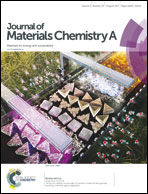Nanoarchitecture of MOF-derived nanoporous functional composites for hybrid supercapacitors†
Abstract
A new nanoarchitecture approach based on metal–organic frameworks (MOF) is reported that can achieve high electrochemical energy storage via utilizing both electric double-layer supercapacitive and pseudocapacitive properties within a single nanoporous composite particle. Herein, a predesigned Co2+-excess bimetallic hybrid Co/Zn zeolitic imidazole framework was used to fabricate a composite containing N-doped nanoporous carbon with a rich carbon nanotube (CNT) content on particle surfaces without H2, with the carbon coexisting with Co nanoparticles (NPs) and Co3O4, through controlled carbonization at 800 °C and subsequent oxidation at 250–300 °C. Optimized nanoporous carbon composites were obtained by tracking the formation of Co3O4 and destruction of N-doped nanoporous carbon (NPC) via detailed X-ray diffraction and X-ray photoelectron spectroscopy analysis. The resulting material showed a high surface area of ∼202 m2 g−1 and included coexisting micro- and mesoporous N-doped carbon, CNTs, Co NPs, and Co3O4 (15 nm in size) after a thermal oxidation process in air at 250 °C for 5 h. Surprisingly, the as-prepared MOF-derived nanoarchitecture exhibited superior electrochemical storage performance, with a capacitance of 545 F g−1 within a wide potential window, achieving up to 320% enhanced capacitance compared to that of pristine nanoporous carbon, which is higher than those of most MOF-derived carbons reported so far. Our strategic nanoarchitecture design for MOFs offers a new opportunity for future applications in high performance energy storage systems.



 Please wait while we load your content...
Please wait while we load your content...